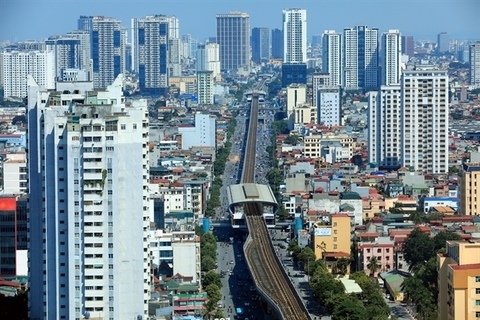|
Việt Nam's logistics real estate is heating up thanks to e-commerce
The strong development of e-commerce in Việt Nam is seeing urban logistics real estate heat up, according to a report of Cushman & Wakefield, a global real estate company.

A view of Hà Nội. In large cities such as Hà Nội, the scarcity of available land funds and logistics facilities forces developers to take advantage of many different types of real estate, often old buildings or vacant land. — VNA/VNS Photo Tuấn Anh
|
Việt Nam has grown to become one of the e-commerce markets with the biggest potential in the ASEAN region. According to the 2020 Southeast Asia e-commerce report by Google, Temasek and Bain & Company, the average growth rate for the period 2020 - 2025 is 29 per cent and by 2025, the scale of Vietnamese e-commerce will reach US$52 billion.
Vietnamese consumers increasingly favour the convenience of online shopping, influencing a wave of shifting storage from retail stores to warehouse space.
It can be seen that the strong development of e-commerce is reshaping the logistics market and creating more diverse types of assets, the most prominent of which is urban logistics real estate, Cushman & Wakefield said.
Urban logistics real estate is receiving a lot of attention from investors. This new field is often confused with the logistics city model, although the concept is quite different.
Logistics city can be understood as an urban model associated with the development of logistics services as a key economic sector.
Normally, logistics cities will be associated with an important type of infrastructure serving logistics services such as international seaports and international airports. Urban logistics is urban-centric, serving mainly consumer needs in cities.
Currently, due to expensive land costs, urban logistics projects are mainly located in the city-fringe or suburban areas.
According to data from Cushman & Wakefield, the Southern key economic region recorded a total warehouse supply of about 5.5 million sq.m of floor space, of which HCM City accounted for about 14 per cent of the total supply.
The Northern key economic region recorded a warehouse supply of about 2.2 million sq.m of floor space, of which Hà Nội accounted for 12 per cent and Hải Phòng accounted for 26 per cent of the total supply.
Besides that, urban delivery costs are also increasing, reaching 50 per cent or more of total supply chain costs.
Therefore, e-commerce investors are eager to acquire logistics real estate that can reach the inner city within a 30-minute drive. This is also the top priority goal of developers to increase competitive advantage.
In HCM City and Hà Nội, the scarcity of available land funds and logistics facilities forces developers to take advantage of many different types of real estate, often old buildings or vacant land. However, older buildings have higher risks and are less efficient for activities such as unloading and storing goods.
Logistics warehouse locations near inner-city delivery points are still a top priority for third-part logistics companies, e-commerce retailers and parcel companies.
In some cases, these old buildings are refurbished to relatively better quality, helping service provider deliver goods quickly.
The report noted that there is currently a large gap between the required urban logistics space and the actual amount, and closing this gap requires investing time and capital to address barriers to operating logistics services in cities.
Local authorities and investors need to strategise for the "urban spatial model". Quantify the total demand for urban logistics space in leading e-commerce markets in Việt Nam based on current and future online sales volumes.
In the coming years, there is a possible future scenario with warehouses being built underground, traditional trucks converted to electric vehicles, which can solve concerns from stakeholders regarding noise and air pollution from delivery vehicles, according to Cushman & Wakefield.
The urban logistics system is the foundation for urban development. To remain competitive, attractive and environmentally friendly, cities must engage in solutions that reduce the costs and constraints of urban logistics.
Focus on investing in developing passenger transport infrastructure, logistics infrastructure, increasing cargo handling capacity, capacity of seaport warehouses, and investing in proactive supply chains to form service supply centers on a regional level.
At the same time, cities will also need to gradually restructure the market share, giving priority to developing rails, inland waterway and air transports to reduce pressure on road transport.
Bizhub
|